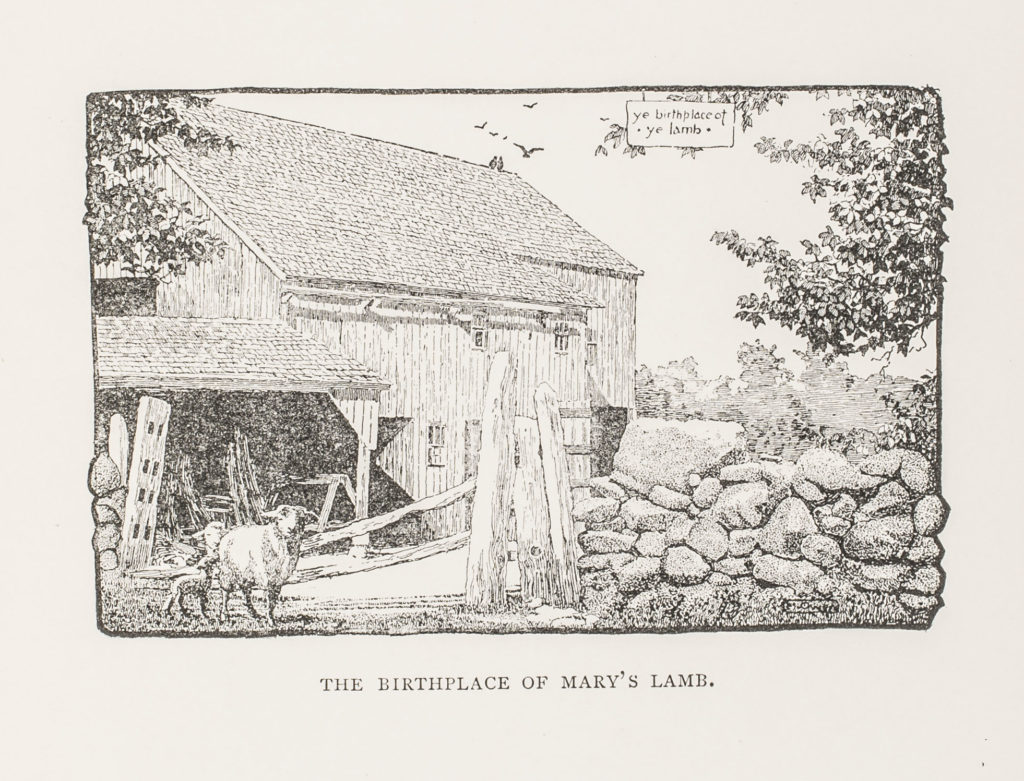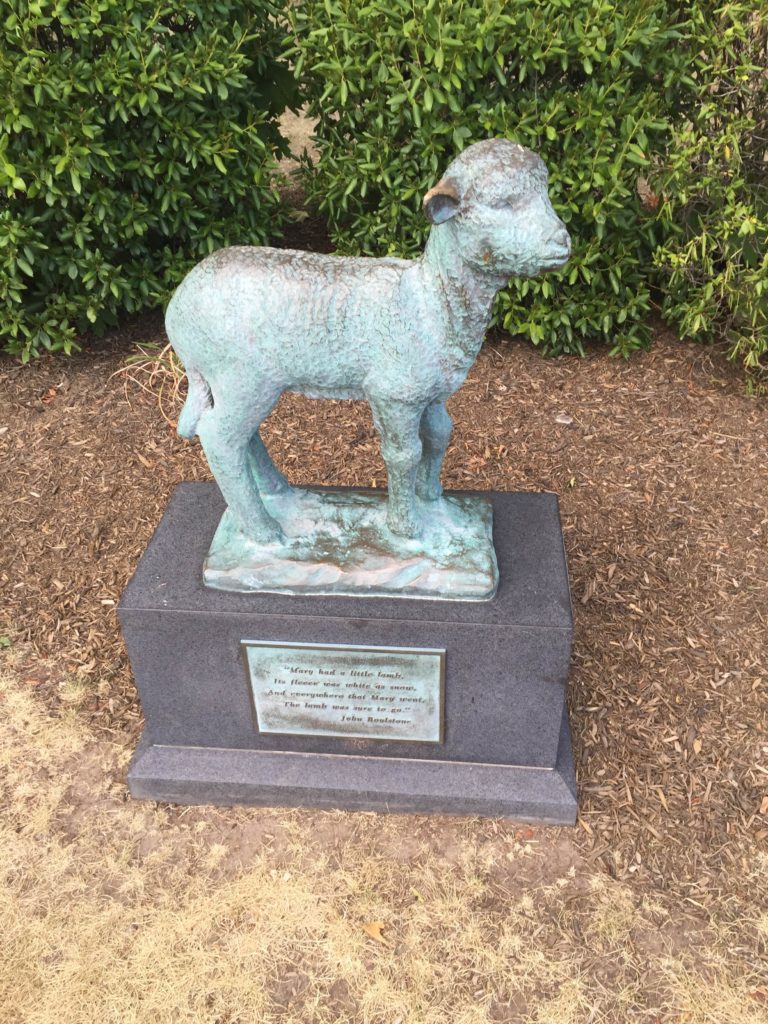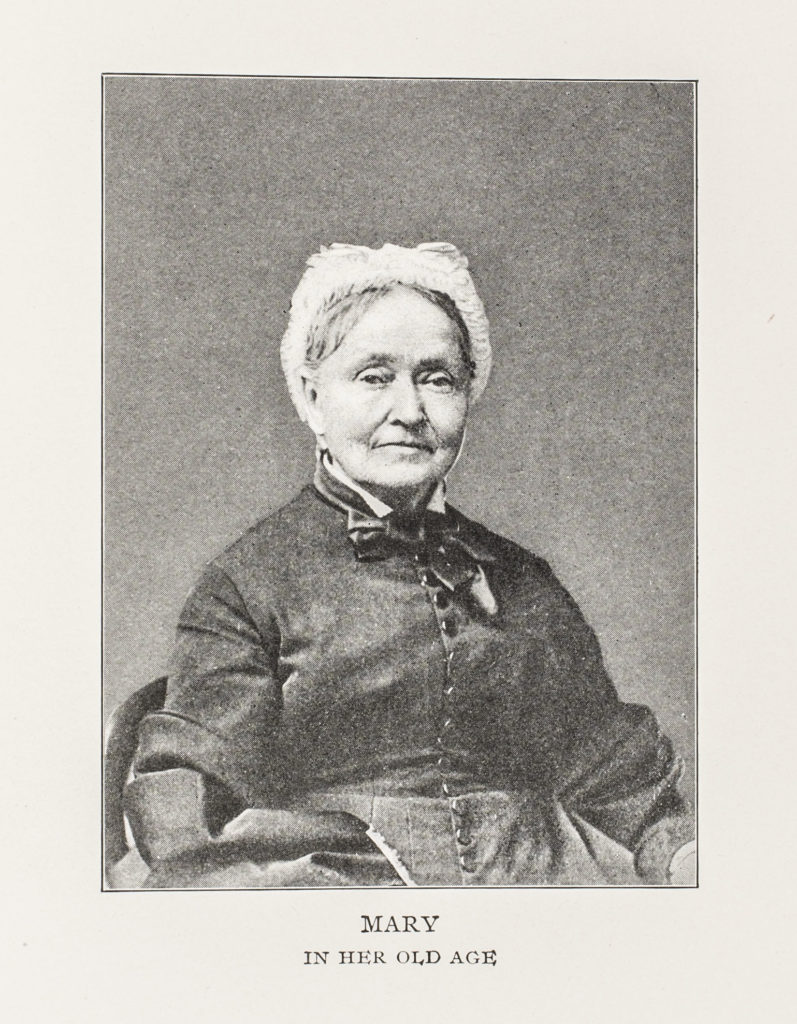Ali Phaneuf is a rising sophomore at Fairfield University and is currently a readers’ services summer page. As a journalism major and an art minor, Ali has always been an avid book reader, and her love of books and creativity was able to grow through her experience at AAS.
The story of “Mary had a Little Lamb” has been sung to children throughout the past two hundred years, and despite the countless times I have listened to this rhyme, it wasn’t until I overheard my sister singing it to my six-month-old niece that I began to wonder how Mary’s story came to be. During my time as an AAS summer intern, I was able to research the surprisingly extensive history of Mary and her lamb. Few people may realize that the popular tale derives from Mary Sawyer of Sterling, Massachusetts. When I discovered that the famous Mary lived in the town just next to my own I wanted to learn more about her and her renowned story.
A quick search in the AAS catalog led me to a book entitled Mary had a Little Lamb, The True Story by Fannie Dickerson, which was published in 1902, just three years following the death of Mary. Not only does Dickerson explain the true story of Mary Sawyer, but she also includes a personal memoir of Mary within the text. Dickerson’s light-hearted book brings new light and meaning to my perception of what I once saw as a mere children’s tale.
 Mary’s story begins circa 1816 when her family’s sheep gives birth to two baby sheep. Problems arise when the mother cares for only one of the two and neglects the other. Mary’s innocence and compassion for others is immediately evident when she finds the lamb the next morning and is distraught at the sight of the poor animal. After much coercing Mary is able to persuade her father to take the lamb inside their house; she gives it food, drink, and warm blankets and decides to sleep with it that night. When Mary wakes the next morning she is elated to see the lamb strong enough to stand on its own.
Mary’s story begins circa 1816 when her family’s sheep gives birth to two baby sheep. Problems arise when the mother cares for only one of the two and neglects the other. Mary’s innocence and compassion for others is immediately evident when she finds the lamb the next morning and is distraught at the sight of the poor animal. After much coercing Mary is able to persuade her father to take the lamb inside their house; she gives it food, drink, and warm blankets and decides to sleep with it that night. When Mary wakes the next morning she is elated to see the lamb strong enough to stand on its own.
Mary later teaches her lamb to walk and brings it outside to interact with other animals. Dickerson explains that there are few girls who live near Mary, and so when Mary is not as school she spends most of her time at home with her animals. Due to Mary’s constant presence, her lamb becomes increasingly attached to her, and thus begins the story of the nursery rhyme we know today.
One day before school Mary forgets to say goodbye to her lamb and calls out to it. Mary’s brother Nate, who is constantly causing mischief, proposes to Mary that she take the lamb to school. Naive about the consequences that lay before her, Mary agrees to Nate’s proposal. Mary conceals the lamb beneath her coat and tells the lamb to remain under her desk throughout the day. Perhaps too trusting of the lamb’s obedience, Mary is horrified when she is called forward to recite lines and the little lamb follows her up to the front of the classroom. It comes as a shock to Mary when all of her schoolmates, including her teacher Miss Kimball, begin to laugh.

Adding to the excitement of the day, there happened to be a special visitor at the schoolhouse, John Roulstone. Roulstone is described as a young man who is preparing for college by living with his uncle, Reverend Lemuel Capen. Dickerson explains that it was customary at this time for students to prepare for college by studying with ministers. John decided to visit the schoolhouse the day Mary brought her lamb and was consequently thrilled that he had gone. The next day John rode over to Mary and showed her a poem he had written about her and her lamb. The poem was comprised of three stanzas and was later completed and published in 1830 in the collection Poems for Children by Sarah Hale through the Boston publishing firm Marsh, Capen and Lyon. Hale’s published version of the poem included two additional stanzas following the original three. Dickerson explains to her readers that although Hale is commonly assumed to be the original author of “Mary had a Little Lamb”, this is not the case; she simply expanded upon the poem that had already been written by eyewitness John Roulstone.

Mary’s story is one that brings smiles to many children throughout the nation, yet her legacy doesn’t end with the conclusion of her nursery rhyme. One Thanksgiving morning years later, Mary’s lamb was gored by a family cow. Mary’s mother made two pairs of socks for Mary from the wool of the little lamb. These socks served a special role in history due to Mary’s decision to unweave them and sell strands of the wool accompanying her autograph in order to raise money to preserve Boston’s Old South Meeting House. The Old South Meeting House is home to many historical memories, including the 1773 meeting of seven thousand Boston citizens that resulted in the Boston Tea Party. Mary was able to earn one hundred dollars from her wool, equivalent to about three thousand dollars by today’s standards.
Mary and her little lamb serve not only as a childhood nursery rhyme, but they also serve as a statement regarding the importance of preserving American history. In Dickerson’s book there is a section where Mary tells her version of the story and admits that had she known taking her lamb to school would have brought about so much publicity, she isn’t sure she would have gone through with it. Mary’s tale demonstrates how a seemingly minute story can grow into something so much greater. It makes me wonder how many of these children’s tales developed from such intriguing backgrounds.
Working at AAS has been nothing short of inspiring. The dedication of the entire AAS staff has helped me to realize that information available on the Internet only scratches the surface of what one may discover from looking at original documents and books of historical people, places, and events. Interacting with so many incredibly intelligent people opened new doors to different ideas and options I have regarding my own path in life. This summer I was not only able to meet with scholars from across the country, but I also made relationships with other interns and finally got to conduct some of my own research as well; overall the self-satisfaction I received while at the AAS is truly immeasurable.

Great story! This needs to be shared! Do you mind if I share with History of Boston group? Nice job and continued success at Fairfield.
Absolutely! Please share with whoever you think would be interested!
Shared and already plenty of interest. Facebook group History of Boston.
I would love for you to share my piece, thank you so much for the support!
Professor Allison, Chair of the Suffolk University History Department, likes this also. Great work!
Mary Sawyer’s family home in Sterling, MA was the victim of arsonists but the Old Schoolhouse is part of the collection at the Wayside Inn in Sudbury, MA.
Thank you for doing this research and writing such a good essay! What a great experience to work in the AAS, and happy to see you taking the opportunity to do this work.
Thank you so much for your kind words and support!
Sterling thanks you for a wonderful paper.
Thank you, I’m glad you like it!
As the birthplace of Sarah Hale Newport takes issue with this story. Please learn more about this issue on our website http://newport.lib.nh.us/sarah-josepha-hale/who-wrote-mary-had-a-little-lamb/
Thanks, Andrea!
Thank you for this alternative perspective